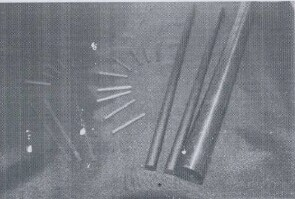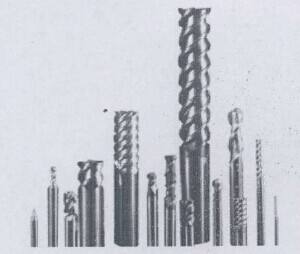本文要和大家探讨的问题源自“硬质合金圆棒”的归类难题。首先我们先来认识下该商品:
硬质合金圆棒(下图一),成分配比:94%碳化钨、6%钴;晶粒度:0.4微米;规格尺寸:直径从1.0mm-45.0mm不等,长度有300mm、310mm、200mm等;生产工艺流程:原料碳化钨、钴配比混料、干燥——压制成型——高温烧结——根据角度尺寸要求精细切断、喷砂处理——制得硬质合金圆棒;用途:产 品出口后不需要再进行切削或其他研磨工序,仅经过开刃之后就可以形成刀具(下图二),安装在机床上使用。
图一 图二
该商品在确定商品编码时主要涉及三个意见:
意见一:如图一所示的报验状态,尚未制成成品,应按照材料类商品归类,其材质为碳化钨和钴、属于金属陶瓷,归入税号8113.0090.90;
意见二:该商品是尚未开刃的刀杆,且报验时也未装在任何刀具上,所以符合品目注释对8209的描述,建议归入税号8209.0021;
意见三:该商品无需焊于或夹于车刀、铣刀、钻头、模具或其他高速切割工具上即可使用,所以不能算作刀头或刀杆,虽未开刃,但按照归类总规则二(一),还是可以按制成品,作为机床的可互换工具归入品目8207中。
归类分析:
以上三个品目,在《品目注释》中都有互排的描述:
品目81.13 金属陶瓷及其制品,包括废碎料
“本品目不包括:
……
(二)制造工具用板、棒、刀头及类似品,用主要成分为粘聚的金属碳化物的金属陶瓷制成(品目82.09)。”
品目82.09 未装配的工具用金属陶瓷板、杆、刀头及类似品
“……上述货品不论是否磨刃或经其他加工,只要未装于工具上,均归入本品目;否则应按工具归入相应的品目,主要是品目82.07。”
品目82.07 手工工具(不论是否有动力装置)及机床(例如,锻压、冲压、攻丝、钻孔、镗孔、铰孔及铣削、车削或上螺丝用的机器)的可互换工具,包括金属拉拔或挤压用模以及凿岩或钻探工具
“本品目不包括:
……
(五)金属陶瓷制成但未装配的工具用板、杆、刀头及类似品(品目82.09)。”
要对以上三个税号进行一一分析和排除,我们还是先得着眼于商品本身属性。该“硬质合金圆棒” 由原料碳化钨、钴配比混料、干燥——压制成型——高温烧结——根据角度尺寸要求精细切断、喷砂处理最终制得,出口后仅开刃便可安装于机床使用,其加工尺寸、加工工艺已使该产品具备特殊用途,因此,按照一般金属陶瓷制品归类欠妥。
其次,争议颇多产生在品目8209与品目8207之间,其矛盾的焦点落在如何理解品目注释8209下“上述货品不论是否磨刃或经其他加工,只要未装于工具上,均归入本品目;否则应按工具归入相应的品目,主要是品目82.07。”中的“只要未装于工具上”。坚持归入品目8207的意见认为,该商品取名为“硬质合金圆棒”是因为行业上统一如此命名,其功能实际为整体硬质合金刀具也即为工具故不存在装于工具上使用一说,因此不能简单的将此商品按照“金属陶瓷棒”归类。那么对于“未装于工具上”的理解确实是如以上所述吗?笔者在查询我国公开归类决定之后未果的情况下,参考了相关商品在美国海关Ruling中的解释:
NY J81908
April 3, 2003
CLA-2-82:RR:NC:1:104 J81908
CATEGORY: Classification
TARIFF NO.: 8209.00.0030; 8207.50.2080
Mr. Craig M. Schau
Emery Customs Brokers
6940A Engle Road
Middleburg Hts., OH 44130
RE: The tariff classification of tungsten carbide tool blanks from the U.S. and other countries and eligibility for partial duty exemption under 9802.00.50 and 9802.0060
Dear Mr. Schau:
In your letter dated March 5, 2003 on behalf of Rogers Tool Works, Inc. of Rogers, Arkansas you requested a tariff classification ruling.
Samples of tungsten carbide tool blanks of various grades, part numbers P71006R, P71031R, P71014R, T2587810R and
227314R have been provided. These U.S. made blanks are in the form of rods approximately 1 ½” long. The first three are 1/8” in diameter while the fourth has a ¼” diameter.
The last, part number 227314R, is also approximately 1 ½” long however it consists of a 1” shank with an 1/8” diameter brazed to a ½” long rod blank of approximately 5/16” diameter which will be machined into the cutting portion of a reversed shank drill bit. All
of the blanks are produced out of a carbide powder also manufactured in the U.S. You have since confirmed by your e-mail of March 31, 2003 that the blanks are made of sintered tungsten carbide.
The samples will be returned as requested.
At present, your client manufactures these blanks and ships them overseas where they are subject to grinding, fluting, pointing, washing, inspection, ringing and packing and labeling. The order of processing does not vary. The resulting drill bits, router bits, etc. will be used for printed circuit board production. Pointing is the cutting and grinding of
the
tool point. Ringing is the attaching of a plastic ring to the bit in a ring setting machine. The rings serve to identify the product by labeling and color coding. In addition, the rings can be adjusted and used as a depth gauge.
The applicable subheading for the tungsten carbide blanks,
except for part number 227314R, will be 8209.00.0030, Harmonized Tariff Schedule of the United States (HTS), which provides for plates,
sticks, tips and the like for tools, unmounted, of cermets. The rate of duty will be 4.6 percent.
Since part number 227314R consists of a shank portion of a tool mounted to a cutting portion by brazing, classification cannot be under 8209.00.30. As noted above, part number 227314R is a sintered tungsten carbide blank for a reversed shank drill bit. (You
have also indicated in your e-mail of March 31, 2003 that the blanks are created in specific sizes for use only as specific end products.)
The applicable subheading for part number 227314R will be 8207.50.2080,
HTS, which provides for interchangeable tools for handtools, whether or not power operated, or for machine tools …: tools for drilling, other than rock drilling, and parts thereof: with cutting part containing by weight over 0.2 percent of chromium,
molybdenum or tungsten or over 0.1 percent of vanadium. The general rate of duty will be 5 percent..
分析以上这个美国海关ruling,我们基本上可以明白品目8207与8209的区别:
有此可以推断,意见三中对“未装于工具上”理解不准确,即使作为完整的刀具可以直接安装在机床上使用,也不应该视为完整的机床用可互换工具进行归类,品目8209中所称的“工具”指的是被焊于或夹于车刀、铣刀、钻头、模具或其他高速切割工具,换言之,只要是没有被焊于或夹于车刀、铣刀、钻头等上,即便可以作为切削工具直接使用,仍然不符合品目8207对机床用可互换工具的定义,不能归入品目8207项下。那么,我们再回过头看本文探讨的这一产品:虽本硬质合金圆棒出口后不需要再进行切削或其他研磨工序,仅经过开刃之后就可以形成刀具直接使用,但其并未焊于或夹于任何刀具上,而是直接安装在机床上使用,虽其功能类似于可互换工具,但其结构还是未超出品目
8209的描述,因此,该产品仍应归入该品目。
以上为笔者个人观点,如有不当,欢迎指正!




